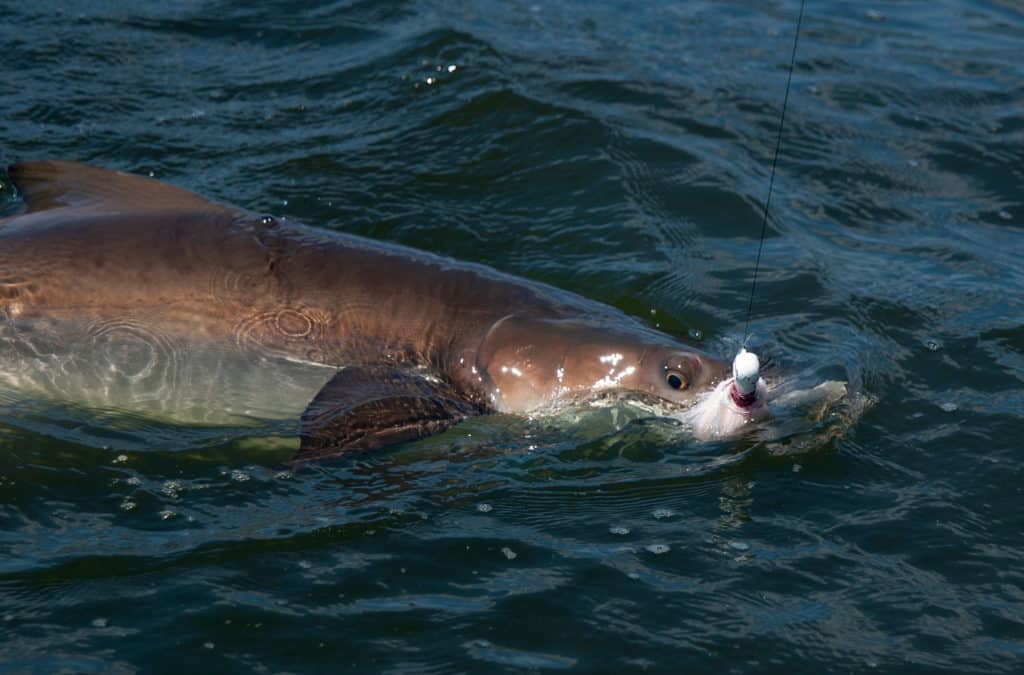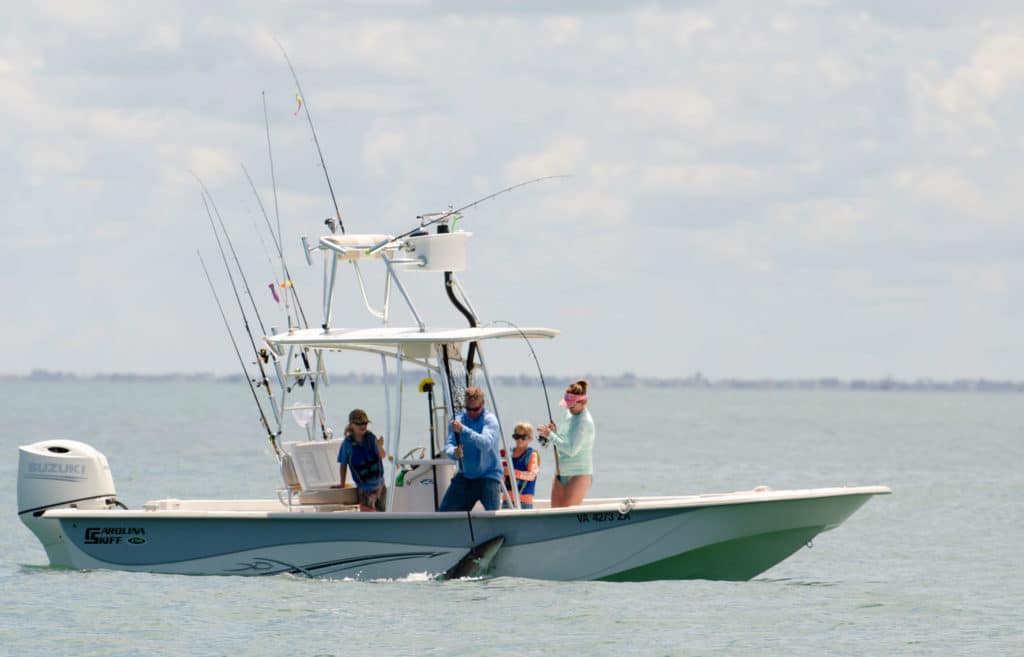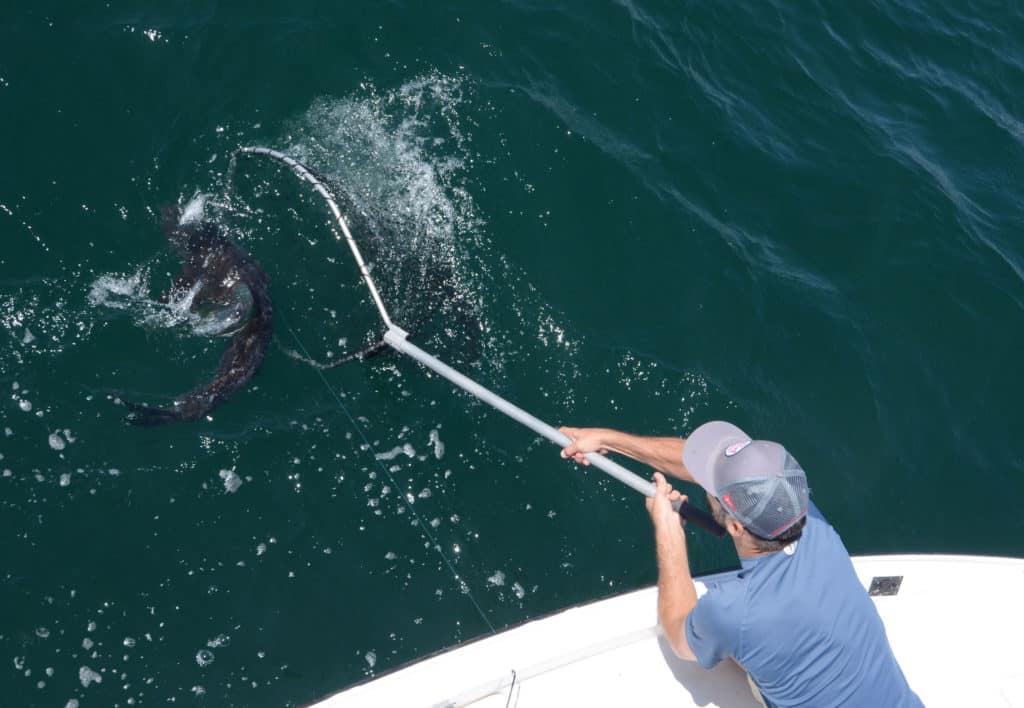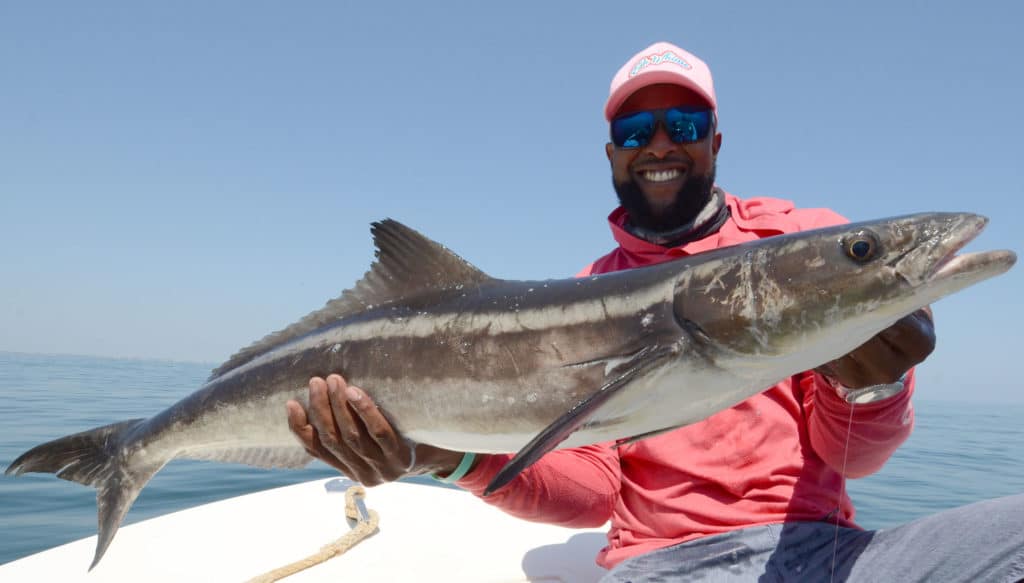
I remember seeing my first free-swimming cobia. I’d heard reports about Florida and North Carolina anglers bringing their sight-fishing skills to my home waters of the Chesapeake Bay. I had to try that technique.
Since we needed full sun to spot a fish on the surface, I didn’t even launch the boat until 9 a.m. The summer day was glass calm, hot and humid. I stood at the helm of my 20-foot Jones Brothers bay boat; my brother Roger took the bow position, holding a heavy spinning rod baited with a 2-ounce bucktail. We zig-zagged at 6 knots up the Chesapeake Bay on the lookout.
With perfect sight-fishing conditions, we quickly spotted a fin cutting a V wake across the mirrorlike water.
As I worked the boat closer, we saw a 4-foot long brown fish swimming just below the surface. I slowed the boat; Roger launched a cast, and the lure landed a few feet ahead of the cobia. The fin swirled, and the brown fish pounced on the lure. Roger came tight and hooked the fish.
Easy, right?
Judging by that first try, sight fishing seemed easy. But if that was true, why do 10 percent of cobia anglers seem to catch 90 percent of the fish? To improve my game (and yours), as the cobia linger through late spring and early summer, I called three top pros and asked for some of their secrets. With new tools now in my box, I’m looking forward to looking for cobia.

First Find
Sight-fishing for cobia requires driving around a big ocean looking for a small brown dot. To narrow the odds, scan for bait pods, color or temperature changes, circling birds, turtles, sharks and rays. Cobia also hide around structures like buoys or pilings. Basically, anything out of the ordinary could hold a curious cobia.
But consistently finding the fish takes more knowledge and effort. Guides who are on the water day after day track trends year after year. To truly target cobia, they have to predict the unpredictable.
Off of Destin, Florida, often considered the Mecca of cobia sight-fishing, Cameron Parkhurst, co-captain of the Instigator Fishing Team, says the season has seemed shorter in recent years, and it tends to wax and wane.
Parkhurst theorizes that cobia ride ocean currents from Brazil into the Gulf. Any disruption in the current could result in fewer cobia passing northwest Florida.
With current playing a big part in cobia behavior, Parkhurst pays close attention to the direction and speed the coastal water moves. “Cobia are lazy and will use every advantage to migrate,” he says.
Parkhurst prefers current-against-wind conditions. “This seems to bring the fish to the surface,” he says. Choppy seas also make it easier to spot the fish riding the face of a wave.
On Florida’s east coast, Capt. James Dumas of Drum Man Fishing Charters has also seen tougher cobia conditions. “The last few years have been horrible,” Dumas says bluntly.
For Dumas, manta rays hold the key to finding cobia. As the giant winged fish glide down the beach, cobia follow in their wake. One ray can have a dozen cobia in tow, he says.
To start his search, the captain first puts water between himself and other anglers. South of St. Augustine, the next navigable inlet lies 40 miles away. Fishing the area in between, which Dumas calls “the desert,” gives him easier access to unmolested rays.

Cautious Approach
Just because you see a cobia doesn’t mean you’ll get a chance to cast. Every time I spot a cobia, buck fever begins. I scream and point, ordering my friends around the boat while trying to get in position for a cast. In contrast, cobia pros remain cool and calculated in their approach.
Capt. Donnie Davis of DOA Charters, who fishes the North Carolina Outer Banks for cobia and red drum, maneuvers his boat to match the fish’s speed and parallels its direction. He carefully closes the distance until he moves just inside casting range. “I want to make the longest cast possible,” he adds.
Davis positions the boat so that the fish swims directly off to the side or slightly behind him. When the fish takes the bait, Davis can motor ahead to help drive the hook home.
As the angler fights the fish, Davis keeps the boat in gear so the fish stays off the stern. “If I lose a cobia in the motor or under the boat, it’s my fault,” he says
When it comes to hooking a cobia, Cameron Parkhurst advises captains to develop a strategy. Parkhurst keeps two live eels, two 2-ounce bucktails and a live pinfish or ruby lips ready to deploy. “First we throw the eel and then follow-up with the live bait,” he says. When Parkhurst finds a cobia school, he uses the bucktail to entice smaller fish away so he can target the biggest cobia with an eel.
When Dumas spots a ray holding cobia, he approaches carefully. “If the ray goes down that’s it,” he says. Dumas used to turn off his outboard and drop the trolling motor, but he says the change in pitch spooks the fish.

Tackle Time
While anglers often describe cobia as curious and aggressive, these fish can also be frustratingly picky. The trick to teasing a fussy cobia into taking your bait comes down to the details.
The typical cobia rod and reel comprises a medium-heavy to heavy action spinning rod paired with a 5500- to 8000-size reel. Use the heavier set up for heavy jigs and big live baits; the lighter combo best casts a live eel.
Spool the reel with 30- to 50-pound braided line tied with a line-to-line knot or a 250-pound swivel to a 2-foot, 40- to 80-pound fluorocarbon leader. Clearer water and finicky fish call for lighter leader.
Starting with this base set up, each pro adds his own personal touch. Davis likes a shorter, 6-foot, 6-inch rod. “I hate to lose a fish close to the boat,” he says. A shorter rod offers more control when the fish is near gaffing range.
To pull a cobia off a ray, Dumas uses large paddletail swimbaits such as the Z-Man Mag SwimZ. “I think the thump of the swimbait’s tail gets the cobia excited,” he explains.
When cobia grow finicky, he switches to a 6- to 8-inch jerk bait on a ½ ounce jighead. “I can cast the jerkbait 60 yards,” he says.
Read Next: Sight-Fishing Cobia off North Carolina
For Parkhurst, the secret to suckering a cobia is downsizing the leader and hook size. He likes to hook a live eel with a No. 4 4X treble hook. He pins the bait through the back just behind the pectoral fins. The small treble and light line are almost undetectable to sharp-sighted cobia.
Little touches like that separate the cobia elite from the masses. This summer, consider tracking migration trends, developing a strategy for approaching the fish, and using the right tackle to up your odds.








